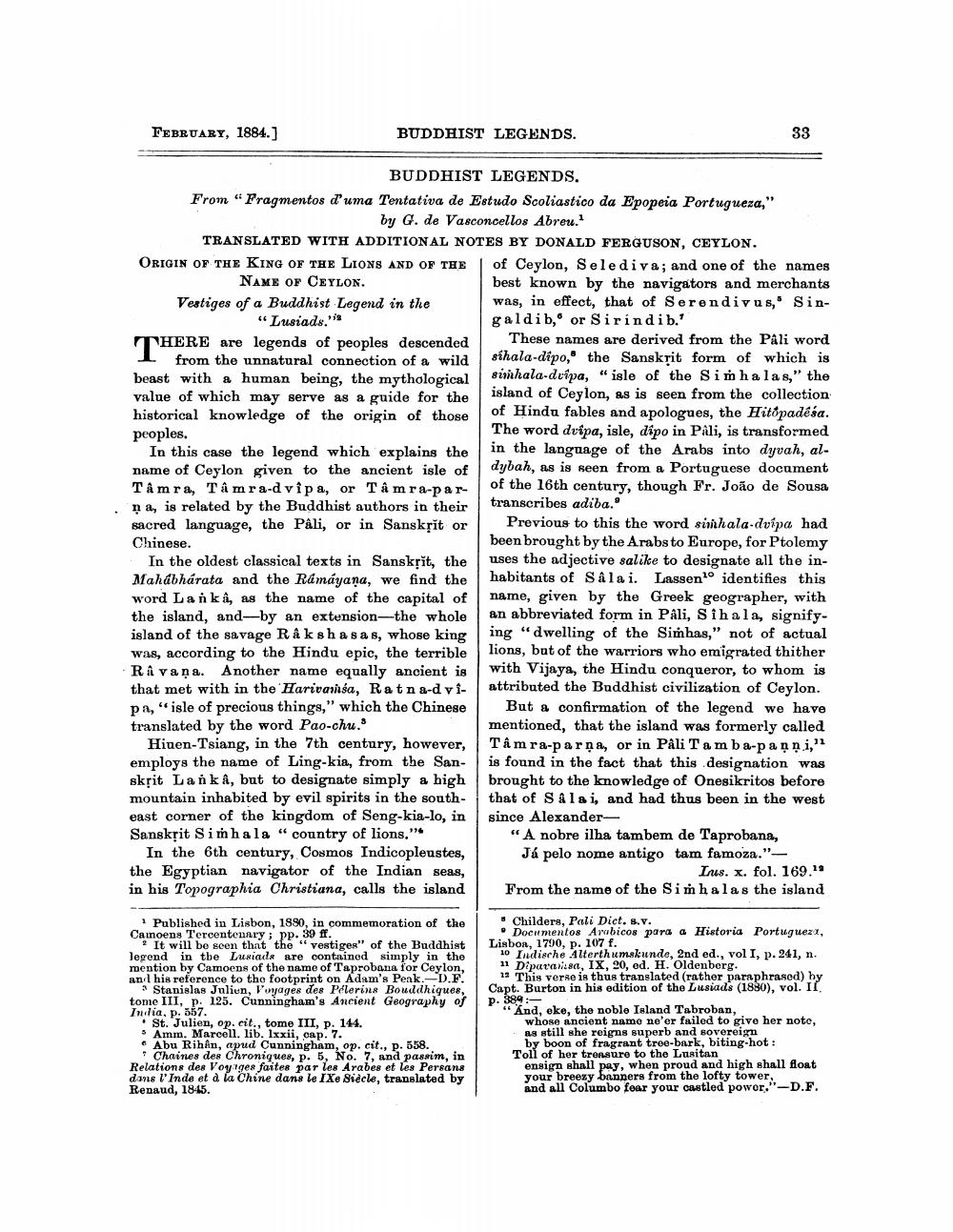________________
FEBRUARY, 1884.]
BUDDHIST LEGENDS.
33
BUDDHIST LEGENDS. From "Pragmentos d'uma Tentativa de Estudo Scoliastico da Epopeia Portugueza,"
by G. de Vasconcellos Abreu. TRANSLATED WITH ADDITIONAL NOTES BY DONALD FERGUSON, CEYLON. ORIGIN OF THE KING OF THE LIONS AND OF THE of Ceylon, Selediva; and one of the names NAME OF CEYLON.
best known by the navigators and merchants Vestiges of a Buddhist Legend in the was, in effect, that of Serendivus, Sin“Lusiads."
galdib, or Sirindib.' THERE are legends of peoples descended
These names are derived from the Pali word from the unnatural connection of a wild
síhala-dipo," the Sanskrit form of which is beast with a human being, the mythological
sinhala-dvipa, “isle of the Sinhalas," the value of which may serve as a guide for the
island of Ceylon, as is seen from the collection historical knowledge of the origin of those
of Hindu fables and apologues, the Hitopadésa. peoples.
The word dvipa, isle, dipo in Pâli, is transformed In this case the legend which explains the in the language of the Arabs into dyvah, alname of Ceylon given to the ancient isle of dybah, as is seen from a Portuguese document Tâmra, Tâmra-d vipa, or Tâmra-par- of the 16th century, though Fr. João de Sousa na, is related by the Buddhist authors in their transcribes adiba." sacred language, the PAli, or in Sanskrit or Previous to this the word sinhala dvipa had Chinese.
been brought by the Arabs to Europe, for Ptolemy In the oldest classical texts in Sanskrit, the uses the adjective salike to designate all the inMahabharata and the Ramayana, we find the
habitants of Salai. Lassen identifies this word Lankih, as the name of the capital of name, given by the Greek geographer, with the island, and-by an extension--the whole an abbreviated form in PAli, Sihala, signifyisland of the savage Rå ksha sas, whose king ing "dwelling of the Simhas," not of actual was, according to the Hindu epic, the terrible lions, but of the warriors who emigrated thither Ri vaņa. Another name equally ancient is with Vijaya, the Hindu conqueror, to whom is that met with in the Harivarasa, Ratna-d vi- attributed the Buddhist civilization of Ceylon. pa,"isle of precious things," which the Chinese But a confirmation of the legend we have translated by the word Pao-chu.
mentioned, that the island was formerly called Hiuen-Tsiang, in the 7th century, however, Tâmra-parna, or in Pali Tamba-panni," employs the name of Ling-kia, from the San- is found in the fact that this designation was skrit Lanka, but to designate simply a high brought to the knowledge of Onesikritos before mountain inhabited by evil spirits in the south- that of Salai, and had thus been in the west east corner of the kingdom of Seng-kia-lo, in since AlexanderSansksit Sinhala “country of lions."
“A nobre ilha tambem de Taprobana, In the 6th century, Cosmos Indicopleustes, Já pelo nome antigo tam famoza."the Egyptian navigator of the Indian seas,
Lus. x. fol. 169.19 in his Topographia Christiana, calls the island From the name of the Sinhalas the island
Published in Lisbon, 1890, in commemoration of the
Childers, Pali Dict. s.v. Canoens Tercentenary ; pp. 39 ff.
• Documentos Arabicos para & Historia Portugueza, ? It will be seen that the " vestiges" of the Buddhist | Lisboa, 1790, p. 107 f. legend in the Lusiads are contained simply in the 10 Indische Alterthumskunde, 2nd ed., vol I, p. 241, n. mention by Camoens of the name of Taprobana for Ceylon, 11 Diparaissa, IX, 20, ed. H. Oldenberg. and his reference to the footprint on Adam's Peak.-D.F. 13 This verse is thus translated (rather paraphrased) hy
. Stanislas Juliun, Voyages des Pelerins Bouddhiques, Capt. Burton in his edition of the Lusiads (1880), vol. I. tome III, p. 125. Cunningham's Ancient Geography of p. 384 India, p. 557.
"And, eke, the noble Island Tabroban, • St. Julien, op. cit., tome III, p. 144.
whose ancient namo ne'er failed to give her note, Amm. Marcell. lib. lxxii, cap. 7.
as still she reigns superb and sovereign • Abu Rihan, apud Cunningham, op. cit., p. 558.
by boon of fragrant tree-bark, biting-hot: " Chaines der Chroniques, p. 5, No. 7, and passim, in
Toll of her treasure to the Lusitan Relations des Voyiges faites par les Arabes et les Persans
ensign shall pay, when proud and high shall float dans l'Inde et à la Chine dans le IXe siècle, translated by
your breezy banners from the lofty tower, Renaud, 18-15.
and all Columbo fear your castled powor."-D.F.




